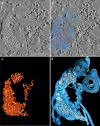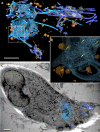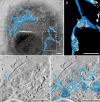Megapinosomes and homologous structures in hematopoietic cells
- PMID: 35829814
- PMCID: PMC9399034
- DOI: 10.1007/s00418-022-02124-x
Megapinosomes and homologous structures in hematopoietic cells
Abstract
Megapinosomes are endocytic organelles found in human macrophage colony-stimulating factor (M-CSF) monocyte-derived M macrophages. They are large (several microns) and have a complex internal structure that is connected with the cytosol and consists of interconnected knots and concave bridges with sizes in the range of 100 nm. We called this structure trabecular meshwork. The luminal part of the megapinosome can be connected with luminal tubules and cisterns that form the megapinosome complex. The structures are especially well visible in scanning electron tomography when macrophages are prepared by high-pressure freezing and freeze substitution. Our research received a new impulse after studying the literature on hematopoietic cells, where very similar, most likely homologous, structures have been published in peritoneal macrophages as well as in megakaryocytes and blood platelets. In platelets, they serve as membrane storage that is used for structural changes of platelets during activation.
Keywords: Blood platelets; Electron microscopy; High-pressure freezing; M macrophages; Megakaryocytes; Megapinosomes; STEM tomography.
© 2022. The Author(s).
Conflict of interest statement
The authors declare no competing interests.
The authors declare no conflicts of interest.
Figures






References
-
- Alberts B, Johnson A, Lewis J, Morgan D, Raff M, Roberts K, Walter P. Molecular biology of the cell. 6. New York: Garland; 2014.
Publication types
MeSH terms
LinkOut - more resources
Full Text Sources
Research Materials

